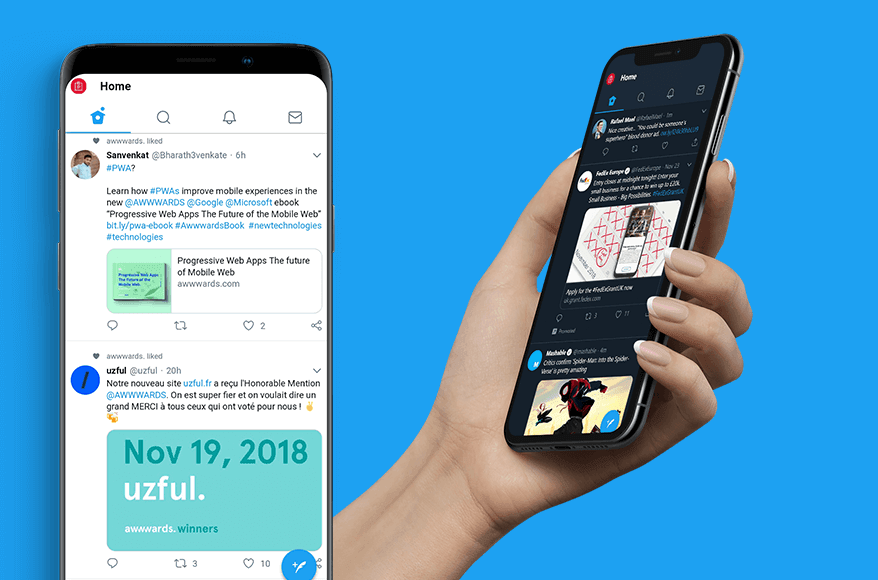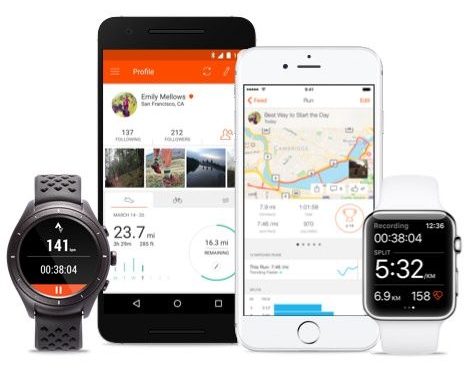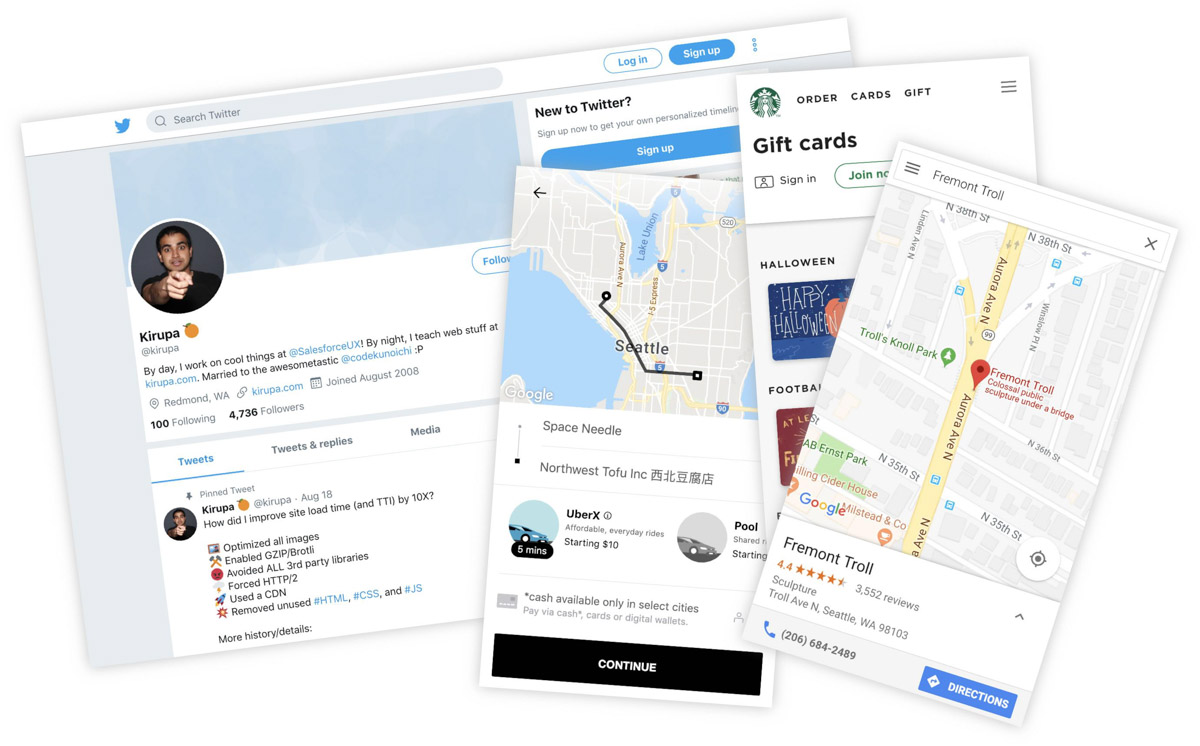Native Apps vs Progressive Web Apps: Which Is Best for Your Business?
When business owners think about ways to scale revenue, the first thing that often comes to mind is a mobile app. In the majority of cases, they choose native apps. However, some entrepreneurs boost their businesses with progressive web apps instead and manage to generate the same revenue as owners of native apps. What are the pros and cons of each solution, and which is better suited for a startup and a big company? Let’s find out.
What is native and what is progressive?
Native apps are built for either iOS or Android. They’re developed according to platform guidelines and are tailored to perfectly fit the target operating system. Developers use native tools, frameworks, and libraries when building native apps. For example, iOS developers use Objective-C and Swift programming languages, while Android developers work with Java and Kotlin. Native apps are known for their high performance and tight interaction with device hardware.
But despite all the advantages of native apps, developing them is rather expensive and time-consuming. Also, creating one native app means focusing on just half of mobile device users – either those who use iOS or those who favor Android. In this way, a single native app fails to appeal to as many users as possible.

Real Estate App by Purrweb UI
This situation has made both business owners and developers look for ways to build cheaper yet profitable apps that are compatible with any platform and any device. Progressive web apps have appeared as one of the alternatives.
Progressive web apps, or PWAs for short, are fully functional web applications that look and feel like native mobile apps. PWAs use an app-like UX to offer app-style gestures and navigation. And since they’re developed for the web, they work on all devices.

Property: web + mobile by Vadim Drut
A PWA has two main use cases:
Web app. A progressive web app allows you to distribute your app to users without needing to send the full app and allows you to overcome issues with unstable network connectivity. Thus, you can increase speed and improve SEO while reducing hosting costs.
Mobile app. A PWA can be distributed as a mobile application via a URL and not via an app store. Such an app can be bundled into a standard mobile app at any time if you want to deploy it on an app store.
What will a PWA mean for your business?
PWAs have been receiving their fair share of interest from businesses ever since they were launched, and they’re receiving a lot more now that organizations like Twitter, NASA, Lyft, Medium, Flipkart, and Starbucks are using them. The features that PWAs provide have made them ideal for businesses that are looking to attain visibility at low cost and with little development effort.

Companies that have embraced web-based apps have released case studies showing how this transition has increased their conversions, acquisitions, and speed to market. Here are some interesting statistics demonstrating how companies have benefited from PWAs:
- Tinder cut the average load time for the app from 11.91 to 4.69 seconds. The Tinder PWA is 90% smaller than the old native app.
- Uber’s PWA takes less than 2 seconds to load, which had a marked impact on search engine rankings, as fast sites rank higher.
- WestElm saw a 15% increase in time spent on the site and a 9% lift in revenue.
- Pinterest saw a 60% increase in engagement and a 44% increase in user ad revenue.
- AliExpress experienced a 104% increase in conversion rates for new users with their PWA compared to the conventional website and app.
- Lancôme’s PWA showed a 17% increase in conversions, a 51% increase in mobile sessions (overall), and a 53% increase on iOS alone.

More companies are now exploring using PWAs as a way to make their businesses more profitable in the short-run.
Perks of progressive web apps
Let’s pay close attention to the benefits PWAs can offer to businesses.
1. App-like look
PWAs look about 95% similar to native apps, giving the overall app-like feel to users. Progressive apps suppress the website feel by providing superior user experiences. They contain a full set of traditional app functionality (navigation, animations, scrolling). They also provide database access and dynamic data.
2. Speed
PWAs are fast. They load faster than X and demonstrate optimized web performance. How are they able to do this? By working faster due to caching executed by service workers. Apart from caching, service workers offer functionality usually performed by traditional apps (offline experiences, periodic background syncs, push notifications).
In turn, increased performance leads to high-quality user experiences and higher retention rates, scoring extra points for progressive web apps.

Source: phpprogrammers.com.au
3. No installation required
Another advantage of PWAs is that they don’t need to be installed on the device, though they still need to be downloaded. Like a traditional mobile application, a PWA gets its own icon on the screen. But it does so while avoiding the installation process. This approach also increases download speeds and significantly reduces the user abandonment rate, as users can easily access the PWA via a URL. PWAs are also easy to share, since all the user needs to do is copy the link and drop it to a friend.
4. Multi-device compatibility
Whether you click a link to a PWA using a smartphone or tablet running iOS or Android or using a computer running Windows or Mac, you’ll get a workable website. There’s no need to build a separate app for each platform, as with traditional apps. This is possible thanks to responsive web design that lets browsers determine what device a user is browsing from and tailor the app accordingly.
All modern browsers other than Safari are compatible with PWAs, so there shouldn’t be any difficulties with the user experience regardless of the device.

5. Forget ASO, welcome SEO
To attain official status, every native app needs to have an app store profile. There’s no way to avoid the tiresome process of app store optimization (ASO) before going to market. ASO ensures that an app meets the technical requirements and guidelines for the App Store or Google Play Store. If your app has any issues with compliance, the app store moderator won’t allow you to publish it until you resolve them.
To gain more users, it makes sense to publish your app on both platforms, meaning you’ll have to go through two app store optimization processes. And approval may take from one to several weeks. Also, note that every future update will have to be optimized as well.
PWAs are launched through a URL and web browser and don’t need to be uploaded to either the Google Play Store or App Store, saving money and time. Another great point of PWAs is their discoverability by search engines. If developed with fundamental SEO principles in mind, a progressive app can become a great weapon in a marketer’s hands.
6. PWAs are faster and cheaper to build
Developing a PWA is much cheaper than developing a native app – and requires less time. Also, PWAs don’t have to meet the standards set by Google and Apple.
In return, PWAs can reach more users, as they don’t depend on a specific operating system and don’t require installation. A PWA can also help startups and small businesses to see a faster return on investment (ROI).
Developing a progressive web app will cost somewhere around $3,000 to $9,000, while developing a native app will cost $25,000 or more.
Developing a PWA is much cheaper than developing a native app – and requires less time. Also, PWAs don’t have to meet the standards set by Google and Apple.
7. PWAs provide security
Security is a priority for all businesses and institutions that deal with users’ data. If an online platform (web or mobile) fails to provide a secure connection for users entering sensitive information, it’s doomed.
New trends and security standards demand that websites dealing with customer data move to HTTPS (Hypertext Transfer Protocol Secure), since the previous HTTP standard is considered insufficient to guarantee data security.
When websites encrypt their data with the help of HTTPS, users can access PWAs safely.
Advantages of native apps
Let’s now consider the benefits of native apps over PWAs.
1. Native apps are even faster
We said that PWAs are fast, but they can’t compete with native apps. PWAs use a browser as a mediator between the operating system and the app. Meanwhile, native apps work directly on the device, processing code faster and providing a better user experience.
2. Full use of built-in device hardware
The strongest point of native apps is their direct access to core device hardware such as GPS, cameras, and Wi-Fi. This makes the user experience more convenient and complete, and it’s something PWAs lack.
PWAs can’t take advantage of all device features because they only run inside browsers and can’t access the operating system properly. Meanwhile, native apps can make use of any feature an operating system and device provides.

3. App Store Optimization is a PLUS
Since native apps have to conform with standards set by Apple and Google, users can be sure the app they download and install is safe. That’s a level of security that even HTTPS can’t provide.
4. Geofencing
Geofencing is a location-based service that triggers an action when a device enters a zone. This feature allows businesses to engage their audiences by sending relevant push notifications about promos, coupons, updates, and security alerts.
Geofencing is a powerful marketing opportunity that can help draw in more customers. However, it can be implemented only in native apps. Geofencing is a perfect complement to brick-and-mortar shops.
To use NFC, an app should have access to the NFC chip embedded in a device. And that’s a task that only a native app can pull off.
5. NFC support
NFC, or Near Field Communication, can be used for a lot of things, though nowadays it’s mostly used for payments. To use NFC, an app should have access to the NFC chip embedded in a device. And that’s a task that only a native app can pull off. PWAs don’t have access to a smartphone’s hardware. So another strong point of traditional apps is that they can provide users with a better purchasing experience.
Here’s a more thorough comparison of PWAs and native apps.
| Factors | Native apps | Progressive web apps |
| Programming languages/framework | Objective-C and Swift (iOS);
Java and Kotlin (Android) |
Ionic framework |
| Responsiveness | More responsive | Less responsive |
| Battery consumption | Low | High |
| Discoverability | Low | Higher |
| Market reach | Restricted | Wide |
| Download required? | Yes | No (can be accessed through a link) |
| SEO-friendly? | No | Yes |
| Interaction with device features | High | Low |
| Interaction with third-party apps | Possible | Not possible |
| Needs to be uploaded to App Store/Play Store | Yes | No |
| Development cost | High | Comparatively low |
Limitations of PWAs
Although a PWA seems like a cheaper (yet viable) solution compared to a native app, there are reasonable concerns keeping businesses from moving to progressive web apps en masse. The two main ones are load speed and performance.
It has been said that PWAs are mostly websites. However, native apps outperform them in functionality. For example, progressive web apps cannot access calendars, contacts, browser bookmarks, alarms, and so on. In addition, they cannot intercept calls or SMS.
Developers use HTML5 or Javascript to build a progressive web app. These high-level coding technologies are not suitable for mobile application development. Consequently, devices have to work harder to interpret the code. This process negatively affects the discharge of the battery.
It should be said that some PWA features like push notifications only work fine on Android devices. Other features not available for iOS PWAs include Face and Touch ID, Siri, and speech recognition.

Another huge drawback of progressive apps is their high battery consumption.
Wrapping up
Now that you know the pros and cons of progressive web apps and native apps, you can choose which is better for your business. If your goal is to generate more revenue and engage more customers while keeping costs low, then a PWA may be the perfect solution. However, if your intention is to make a name for your brand by providing the best user experience, then you should consider native app development, at least in the long-term perspective.


